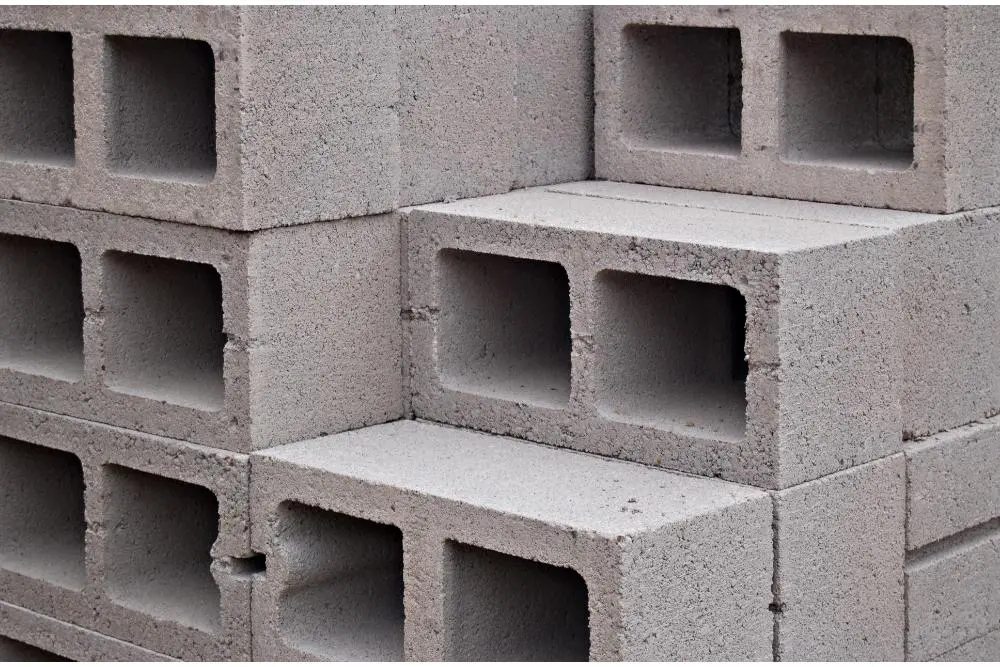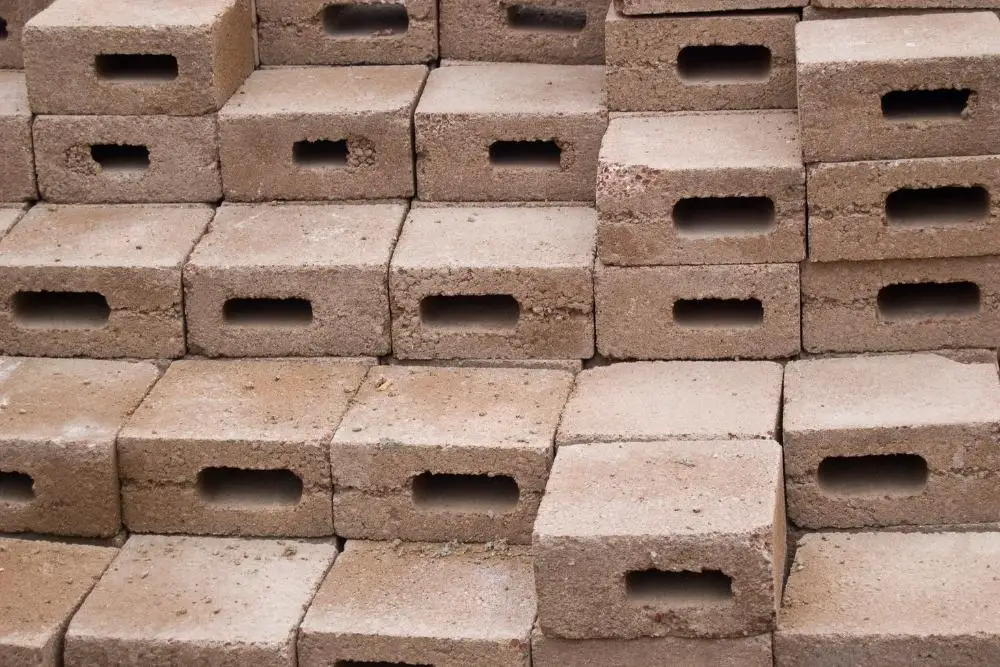Concrete cinder blocks are one of the most common, durable, and cost-effective building materials. They’re used for everything from garage construction to making raised beds in your garden, and no matter who you are, they will come in useful for something.
They have a range of versatile uses, though their primary use is walls, which include both interior and exterior structural walls, partition, retaining, and basement walls.
The only challenge that stands between you and using cinder blocks is their weight. For construction, the heavy weight of cinder blocks is a benefit, but it can pose a few challenges – will your floors support their weight? How many can your truck take?
In this article, I will examine the average weight of different cinder block sizes.
Average Weight of 3 Common Cinder Block Sizes

Cinder blocks (also known as breeze blocks in the UK) began being used ardently with advancements of block machinery around the start of the 20th century.
Innovations in production in the Portland cement industry, as well as good marketing and exposure at the 1904 St. Louis Purchase Exposition, lead to their increased popularity and use.
Concrete masonry units (represented by CMA in short form), are made of a mixture of cement, sand, and water. Cinder blocks are special, as they use industrial and household waste (cold ciders/ash from fires) as their filler component, in the place of sand.
Today, if ash isn’t available, volcanic pumice might be used in its place. This makes cider blocks lighter than non-aggregate concrete masonry units, though they are still of considerable heft.
Cinder blocks are hollow and rectangular, with the hollow part often used for metal reinforcement, or additional concrete for higher resistance.
When investigating the weight of different cinder block sizes, we have to use the qualifier ‘average’, as it is nigh impossible to find a precise, consistent weight for all cinder blocks, even if they are the same dimensions.
Stores that specialize in masonry products might stock different weights of bricks to Lowe’s or Home Depot, despite them being the same size.
Despite masonry standards, these differences could be attributed to the quantity and quality of materials going into the production, natural deviations in density, different end styles, etc.
Professional builders will often use a diverse away of cinder blocks in construction, but the average homeowner, homesteader, prepper, or DIYer only really needs to know about the three most common blocks – 8’’ x 2’’ x 16’’, 8’’ x 4’’ x 16’’ and the most common 8’’ x 8’’ x 16’’ hollow blocks.
8’’ x 2’’ x 16’’ Cinder Block Standard Weight
These small, flat building blocks, from paving slabs for pathways, to use as decorative capstone over other hollow cinder blocks underneath.
Online, masonry stores and home improvement shops list the average weight as 16 pounds (7.26 kg), though there is wiggle room, with around 2.5 pounds potential standard difference from this average weight.
8’’ x 4’’ x 16’’ Cinder Block Standard Weight
These blocks are halfway between the 8’’ x 2’’ x 16’’, and the most common cinder block, 8’’ x 8’’ x 16’’.
They’re a solid block, which can make them difficult to transport, as they are dense and compact, in addition to lacking angles for easy lifting (as the larger block has), and cannot be easily slid about (as the smaller block can).
The average 8’’ x 4’’ x 16’’ cinder block weighs 33 pounds (or 15 kg). Again, there is wiggle room for this, and differences between manufacturers, materials, and styles of block can affect the weight.
Most standard 8’’ x 4’’ x 16’’ cinder blocks fall between the 30 to 34.5 pounds mark.
8’’ x 8’’ x 16’’ Cinder Block Standard Weight
This is the most common kind of cinder block, as is most likely to spring to mind when you think of cinder blocks.
This concrete block is hollow, with two structural holes down the middle, so that structures can be reinforced with materials like concrete or metal rods, or rebar.
Leaving the center of the block hollow cuts the weight of the block, so it isn’t much heavier than the 8’’ x 4’’ x 16’’ block (that is half the height).
The average 8’’ x 8’’ x 16’’ cinder block weighs about 36 pounds on average (or 16.33 kg), though they are generally listed as falling in the range of 35 to 38 pounds.
Complete List of Cinder Block Weights

As you have already read, the three most common types of cinder blocks are by no means the only ones in the masonry market.
Depending on your project, you might be wanting some of the more uncommon seizes, regardless of whatever you need, there will be a cinder block that suits your requirements.
If you can’t find something at the big box stores or local hardware stores, then specialist masonry stores or landscaping businesses will be able to order it in for you, just make sure you phone ahead!
| Cinder Block Sizing (H x W x L in inches) | Average weight (pounds/kilograms) |
| 2 x 4 x 8 block (solid) | 5 pounds/ 2.27 kg |
| 8 x 8 x 8 block (hollow half block) | 23 pounds/10.43 kg |
| 2 x 8 x 16 (solid) | 16 pounds/7.26 kg |
| 4 x 8 x 16 (solid) | 33 pounds/15 kg |
| 4 x 8 x 16 (hollow) | 24 pounds/10.89 kg |
| 6 x 8 x 16 (hollow) | 30 pounds/13.6 kg |
| 6 x 8 x 16 (solid) | 56 pounds /25.4 kg |
| 8 x 8 x 16 (hollow) | 47 pounds/ 21.32 kg |
| 10 x 8 x 16 (hollow) | 46 pounds/20.87 kg |
| 12 x 8 x 8 (hollow) | 31 pounds/14.06 kg |
| 12 x 8 x 16 (hollow) | 58 pounds/26.3 kg |
Overall, these sizes of cinder blocks are available and can be useful for specific products. If you require a specific type of concrete masonry unit, it might be useful to go to a store that specializes in concrete products.
They might even give you a better deal, or even have options for delivery, saving you time, effort, money, and even potentially wear and tear on your vehicle.
Note – this complete list may not actually be complete, depending on when and where you are reading this article from. There are different types of cinder blocks available in different regions, and new blocks are always being put on the market.
Projects with Cinder Blocks
Cinder blocks really are one of the best building blocks for home and DIY projects.
They are low cost, come in a convenient range of sizes, fire-resistant, fairly durable, and easy to get your hands on – meaning they are a totally invaluable resource for anyone who fancies themselves as a bit handy with construction.
Preppers can use cinder blocks to build below ground food storage, retaining walls, raised beds, oven/stoves, protection from gunfire, bunkers or fallout shelters, and flood control.
Cinder Block FAQs
What is the difference between metric and imperial blocks?
Concrete blocks are manufactured to two standard sets of measurements – metric (mm) and imperial (inches). Globally, the industry has manufactured blocks to metric standards since 1979, but America has stayed with the imperial system.
There are equivalent sizes across these two standards – although they don’t line up exactly, potentially as they’re made in different factories.
When two equivalent blocks are measured, the metric unit is slightly smaller than its imperial equivalent, by around 6.9 mm or ⅛’’ in all directions. This means that a metric block could be used to replace an imperial block (by thickening the mortar), but the inverse cannot be done.
What are the benefits of using masonry blocks over poured concrete?
Traditionally, using concrete blocks rather than poured concrete leads to a faster construction time, especially when time taken to cure poured concrete is taken into account. Additionally, the top surfact of a block wall or construction is smooth, whereas poured concrete settles in their forms, meaning they aren’t as even.
Finally, things constricted using blocks are more flexible, as they can be fitted around any shape of door or window without having to create an awkwardly shaped form/mold for the wet concrete.